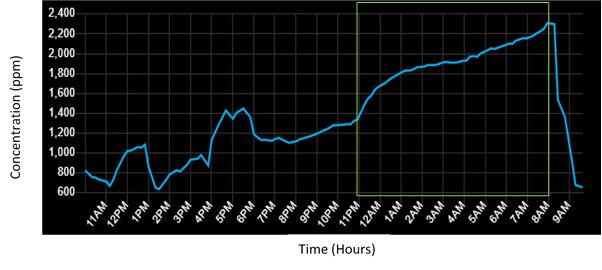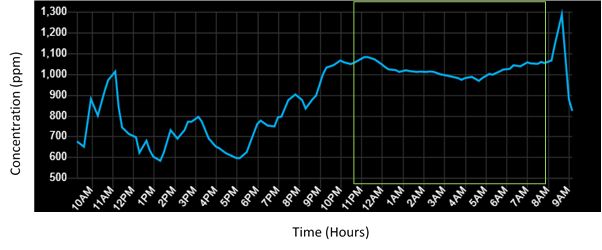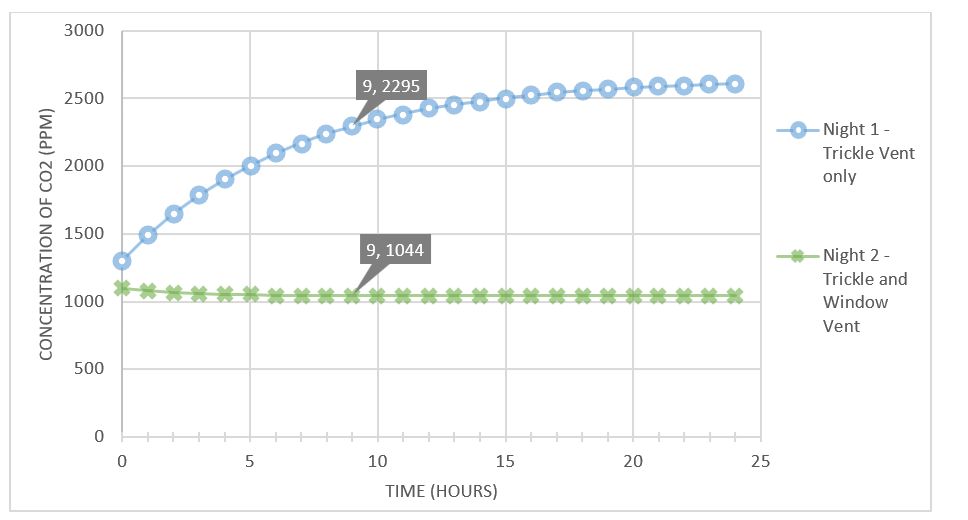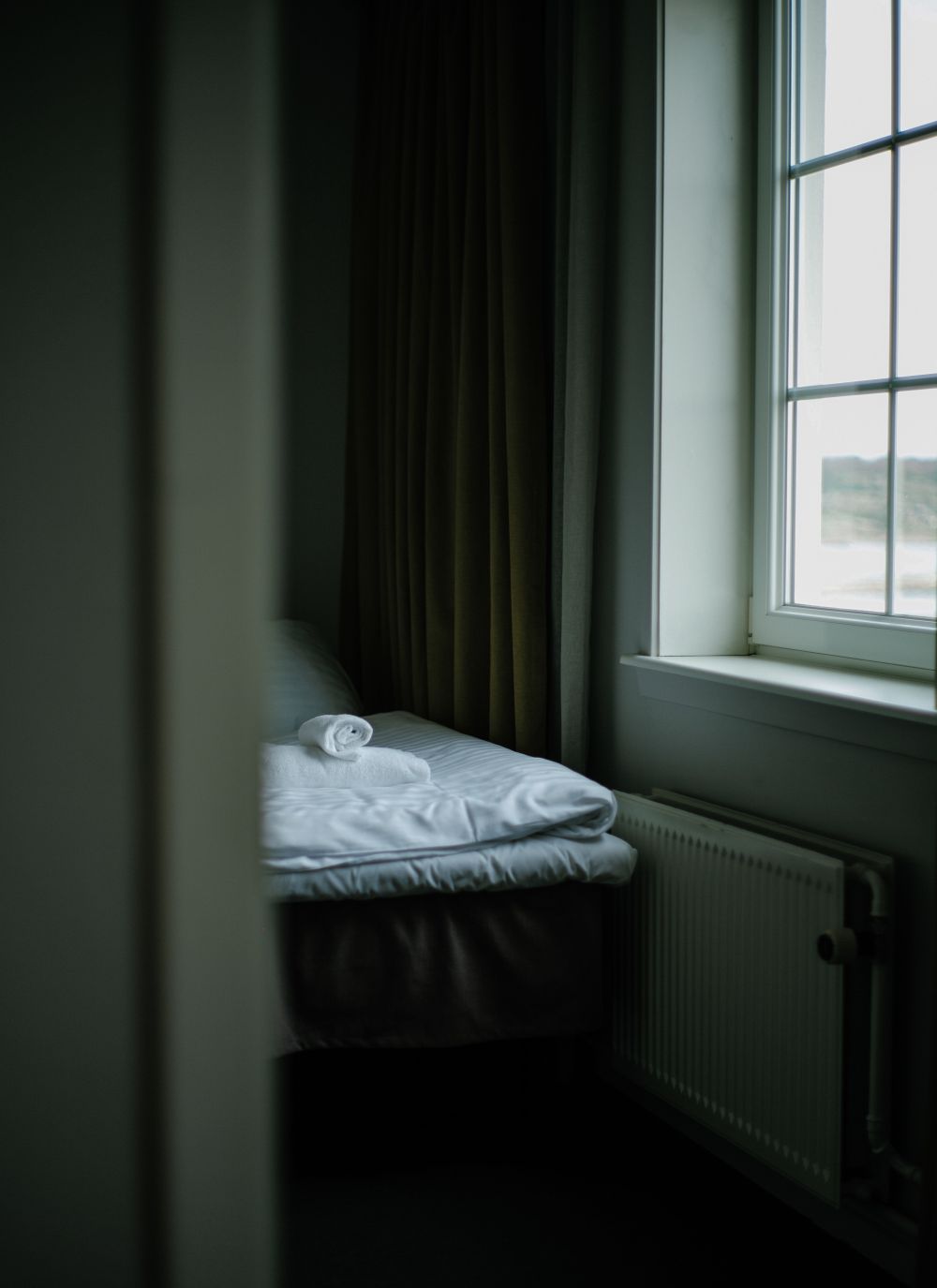Humans need adequate levels of fresh air to be healthy and happy. Without sufficient ventilation, moisture and gases such as CO2 and VOCs (volatile organic compounds) can build up. A well-designed mechanical ventilation system will provide an adequate air change rate to remove stale air, manage moisture build up and provide fresh air.
However the vast majority of buildings in the UK are naturally ventilated, relying on ventilation being provided by the occupants opening windows and some uncontrolled infiltration through a leaky construction. But are we opening windows enough?
During the summer many of us wouldn’t hesitate to open a window to provide a breeze and consequently fresh air. During the winter though you’d be forgiven to leave the windows shut to prevent uncomfortable cold drafts and to limit all our hard earned warm air escaping. As energy efficiency is becoming a greater consideration are we now less inclined than ever before to open the window and increase our energy bill? With a large proportion of the population now living and working in the same room for extended periods of time, air quality could be having a significant impact on our lives.
To understand if and how much of problem this might be we have measured the CO2 in a bedroom with one occupant over two nights specifically focusing on the hours between 11pm and 8am.
Night one had the window closed, only trickle vents open. Night two had the window slightly open locked in the secure ventilation position in addition to trickle vent.
The CO2 levels are shown on the following graphs:
Night 1 – Trickle Vents Only

Figure 1: CO2 concentration in the room over a 24hr period
We can see that the CO2 level started at ~1300ppm at 11pm and rose throughout the night up to ~2300ppm by 8am at which point the window was then fully opened.
Typical CO2 levels and how they impact humans are described below:
- 400 ppm: approximate outdoor air level
- 400-1,000 ppm: acceptable levels of CO2 found in well ventilated spaces
- 1,000-2,000 ppm: Humans will become sensitive to levels in this range, it may begin to feel stuffy or lead to complaints of drowsiness
- 2,000-5,000 ppm: level associated with headaches, sleepiness, and stagnant, stale, stuffy air; poor concentration, loss of attention, increased heart rate and slight nausea may also be present.
- >5,000 ppm: indicates unusual air conditions where high levels of other gases also could be present. Toxicity or oxygen deprivation could occur. This is the permissible exposure limit for daily workplace exposures.
This indicates that from 5am -8am the air quality in the room is higher than ideal and could lead to feelings of drowsiness right when we would be looking to wake up and hoping to feel most refreshed.
Night 2 – Trickle Vents and Window in Secure Ventilation Position

With the greater ventilation rate, the CO2 level reached equilibrium at ~1050ppm (ignoring the anomalous spike at 8:30am). This is a much healthier level of CO2 and more conducive to a good night’s sleep.
Using the following equation and the below assumptions it is possible to estimate a corresponding ventilation rate and verify against measured concentration levels.

c = carbon dioxide concentration in the room (m3/m3)
q = carbon dioxide supplied to the room = 1 person at a rate of 0.018 (m3/h) – this is a significant unknown and can only be estimated
Vr = volume of the room 50 (m3)
t = time (hour, h)
ci = carbon dioxide concentration in the inlet ventilation air (m3/m3) (400ppm)
c0 = carbon dioxide concentration in the room at start, t = 0 (m3/m3)

Using the equation and assumptions above, the graph below can be produced showing how the concentration of CO2 would vary with the assumed ventilation rates in idealised conditions with perfect mixing. Time 0 corresponds to 11pm and time at 9 hours equates to 8am. Where the CO2 levels approximate the measured values.

Figure 3: Idealised model of CO2 concentration in the room with one occupant and assumed ventilation rates.
What is clear from this experiment is that on night one there was not sufficient ventilation in the room and on the second night there was. (It is reassuring to see the ventilation rate approximately corresponds to the minimum ventilation rates recommended by Passivhaus of 30m3/h.person or <0.3 ACH–.) It is worth noting that the ventilation rates calculated using this method are reliant on the figure used for the CO2 emitted by a person (q). An average figure has been used from the available literature on this subject but will vary from person to person. Measuring the decay of CO2 concentration in an empty room would be a more suitable method to determine the air change rate.
What cannot be said for sure is where this fresh air was coming from. It is likely to be a combination of air exchange through the window, some exchange through the door with the rest of the house and some partly due to infiltration through the fabric of the building.
Whilst adequate air change rates were achieved on night 2 with the window in the secure ventilation position, this is not a prescribed level of window opening as this may not be replicated on another night with different weather conditions. For example, a greater temperatures difference between the inside and outside will drive a greater air change rate, as will a particularly windy night.
How to guarantee adequate levels of fresh air in your house:
- Leave your windows open. How much? It depends but probably more than you already are. (Greengauge will not be held liable for high energy bills or discomfort from drafts)
- Design an airtight house (to limit uncontrolled heat loss from infiltration, remove drafts, improve comfort and save the planet) with an appropriately designed Mechanical Ventilation system with Heat Recovery (MVHR).
- Live in a tent.
Written by Jack Preece





